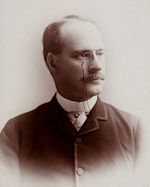
One hundred and fifty years ago, in the summer of 1864, a young man from a small town in central Massachusetts, 23 years old, arrived in New York City hellbent on leaving his mark on the city and the country. Did he ever.
By the time he would die 40 years later, on a frigid January night not long after attending a performance of Parsifal at the Metropolitan Opera, William Collins Whitney's legacy was secure. That incredible museum of American art on Madison Avenue, his children started that. Grover Cleveland, his elections as governor of New York and then as president of the United States don't happen without his friend Whitney, who secured the necessary votes to get Cleveland elected. The United States Navy being restored to glory after decades of neglect following the Civil War, that was Whitney. As President Cleveland's secretary of the navy, Whitney launched a huge shipbuilding push that included putting the battleship Maine to sea, and other ships that would later play huge roles in the Spanish-American War. The free transfer that passengers enjoy when they switch from one bus to another in New York, that was Whitney, too. And oh, yes, then there's the New York City subway, the second oldest subway in America after Boston. New York's subway opened in October 1904, but it might have been delayed for years or maybe decades without William Whitney's help.
Whitney kept his vital role in the subway a tight secret that he took to his grave. Credit, all of it deserved, has long gone to the men who designed, built and financed it, like the brilliant engineer from Columbia University, William Barclay Parsons Jr., and the son of the rich banker, August Belmont, and the portly, mustachioed, hard-drinking Irish contractor who built the first legs of the project, John Bart McDonald. It was almost a full decade after Whitney's death when his role was dramatically revealed.
Throughout most of the 1890s, Whitney, after returning to New York from Washington, D.C., was the king of the street railways in Gotham, much like his older brother, Henry Melville Whitney, was in Boston. William Whitney's biographer would later describe his streetcar role as his "Empire on Wheels." Whitney was there when critical decisions needed to be made, and sometimes he was smart, by allowing free transfers, and other times he erred, as when he pursued the promise of cable streetcars over the proven electric ones. When the opportunity came to bid for control over operating Manhattan's soon-to-be-built subway, Whitney at first did not bid. But at the last minute he threw an offer in, offering to build it in exchange for 5 percent of the annual gross receipts and permanent ownership. Financially, it would have been a good bid for the city to accept. Alas, it was rejected out of fear that letting private interests control the subway, rather than the city government, would leave it vulnerable to corruption, and hark back to the days of Boss Tweed.
"Mr. Whitney and his friends resent the imputation that they are trying to grab something," Whitney wrote in a letter to the city in the spring of 1899. And so he stepped aside, reluctantly, until he would be needed again. That time would come.
The banker Belmont had promised to finance the project, but he needed a charter from the New York State legislature. When he applied for it, he was shocked to discover that the men who controlled the street railways in the city were not exactly thrilled at the prospect of a subway, and their deep political ties managed to block Belmont's charter. Was William Whitney one of those obstacles? Perhaps. But the bonding companies Belmont needed were also suddenly skittish, and, all of a sudden, the subway project that New Yorkers had been dreaming of and demanding for decades was in danger of falling through. As Belmont recalled later when he sough the necessary approval, "I found the door closed."
He needed a friend. A politically connected friend, someone who could push his charter through with a wink, a nod, a handshake, whatever it took. Someone who didn't want the credit, but was willing to help, and someone who would put the good of the city's residents over petty politics and back-room fighting. "I resolved to go straight to a man who was all powerful, or at least most influential with the powers that were, and I did," Belmont reluctantly recalled in a dramatic courtroom moment in 1912. "He promised his help and gave it."
That man was William Whitney. Eight years after his death, the secret he took to his grave was out. William Parsons designed it. August Belmont paid for it. John McDonald built it. But William Whitney made it happen.